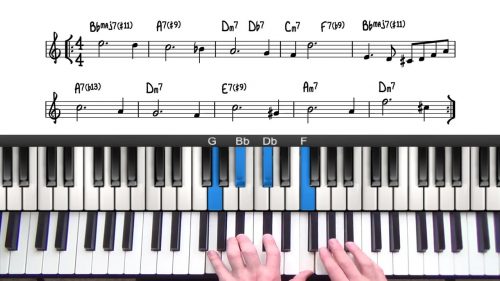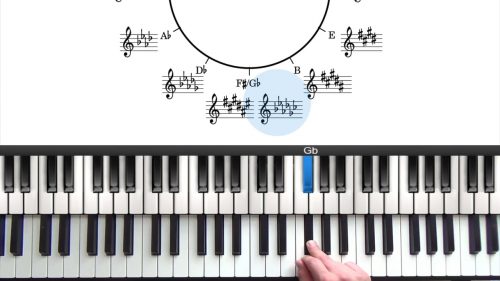Major Modes Lesson
In this lesson we explore the modes of the major scale, explaining what they are and where they come from. There are 12 major scales on the piano, and we can derive 7 modes from each major scales.
We will work through each mode individually and talk about the specific character and sound of that mode so that we can then use this information in our soloing and improvisation.
These modes of the major scale can be used for improvisation over the chords in the major 251 progression and the modes of the melodic and harmonic minor scales can be used to improvise over the chords in the minor 251 progression.
What Is A Mode?
A mode is essentially a scale with an exotic name. We have learnt previously that every major scale has a relative minor scale which contains the exact same notes, but starts and ends on the 6th note of the major scale.
Well in fact, we get a new scale by starting and ending on each of the 7 notes of the major scales.
Each of these different starting points creates a ‘mode’ of the major scale and each has its own unique sound. Furthermore, the 7 modes play a fundamental role in jazz improvisation.
The 7 Modes Of The Major Scale
Every major scale has 7 modes, the modes are called Ionian, Dorian, Phrygian, Lydian, Mixolydian, Aolian & Locrian.
The major scale is called the Ionian mode and the relative minor is the Aolian Mode — so you already know 2 of them — that just leaves 5 left to learn!
There are two ways of teaching modes, in this lesson we explore both approaches.
The Ionian Mode — the 1st mode of the major scale

- The Ionian mode is the major scale
- Very clean sounding but can sound quite plain.
- Contains the major 3rd and major 7th so the Ionian mode can be played over major chords.
- You should be aware that the 4th note of the Ionian mode is what we call an avoid note — it’s called an avoid note because it sounds dissonant against the major chord due to the half step intervals between the 3rd and the 4th.
The Dorian Mode — the 2nd mode of the major scale

- The Dorian mode is the major scale with a b3 and a b7 — this gives the mode it’s minor tonality but this major 6th is what distinguishes it from the Aeolian (natural minor) and makes the scale distinctly Dorian.
- One of the biggest strengths of the dorian mode is that there are no avoid notes when played over a minor chord — how great is that!.. All the notes will sound good.
-
The Dorian mode has a wonderfully smooth and soulful sound and can sound quite hip and bluesy depending on how it is played.
- You could also look at the Dorian mode as the natural minor (Aeolian) but with the 6th note raised by half a step.
- I like to look at the Dorian mode as a minor scale that has been tweaked slightly
- The Dorian mode is used extensively to improvise over most minor chords and is used more than the natural minor itself. Try this out yourself and see which one you think sounds better.
The Phrygian Mode — the 3rd mode of the major scale

- The Phrygian mode is the major scale with b2, b3, b6 & b7. The b3 and b7 give the scale it’s minor quality but the addition of the b2 and the b6 give the scale a Middle-Eastern or Spanish sound.
- In fact, the Phrygian scale is scale used for flamenco music and a lot of traditional Spanish music uses the Phrygian scale
- The characteristic note is the flat 2nd – this is what distinguishes it from the Aeolian mode.
- Something to be aware of is that the flattened 2nd makes this mode very dissonant over a minor 9th chord due to the half step interval between the 9th and the b9.
- At this stage, the Phrygian mode will not be as useful as other modes of the major scales so let’s move on for now.
The Lydian Mode — the 4th mode of the major scale

- The presence of the major 3rd and major 7th means that this scale can be played over major chords.
- The Lydian mode is actually identical to the Ionian mode but with a raised 4th . Raising the 4th removes the ‘avoid note’ we mentioned earlier so this scale is extremely useful.
- It’s very clean sounding, like the Ionian mode, but the #4 gives it a spacey, airy sound that can be used to create a floating quality over major chords.
- The characteristic note is the raised 4th – this is what distinguishes it from the major scale.
The Mixolydian Mode — the 5th mode of the major scale

- The mixolydian mode is identical to the major scale but with a flattened 7th step.
- The mixolydian mode has a funky, somewhat bluesy sound at the top of the scale.
- The flat 7 in the mixolydian mode makes this scale suitable to play over dominant 7th chords.
- The characteristic note is the flat 7th – this is what distinguishes it from the major scale.
- Similar to Ionian mode, the 4th note of the Mixolydian mode is an avoid note and sounds dissonant so remember to handle this note with care.
The Aeolian Mode — the 6th mode of the major scale

- The Aeolian mode is the natural minor scale. You can also look at it as the major scale but with a b3, b6 & b7.
- The Aeolian mode has a dark and melancholy mood and can be used as an alternative to the Dorian mode. However, the Dorian mode is generally the preferred scale to use on minor chords.
- The b6 is the characteristic note which differentiates it from the Dorian mode.
The Locrian Mode — the 7th mode of the major scale

- The Locrian mode is the major scale with b2, b3, b5, b6 & b7 — only the natural 4th remains.
- Since the Locrian mode contains a b3, b5 and b7, it can be used over -7b5 chords.
- The Locrian mode sounds a little Spanish like Phrygian (as shares the same first 4 notes), but with an unresolved, darker tone as you progress up the scale due to the addition of the b5.
- The characteristic notes are the b2 and b5 — particularly the b5 as this is what distinguishes it from the Phrygian.
Lesson Downloads
Major Modes PDF Download

Major Modes PDF Download
13 pages of fully notated major modes in every key. Download for free, print, and play today...
Practice Tips
-
the first step in learning modal theory is to memorise the formulas on the cheat sheet. This will give you a functional understanding of each mode adn how it relates to the major scale.
-
Try quizzing your self on the scale degrees that each mode contains. This can be done away from the piano.
-
Pick a key at random, then pick one of the 7 modes. How quickly can you find the notes? You should be able to easily visualise the mode, the primary chord tones, the upper extensions etc...
-
Don't just play the mode up and down. You can break the mode into triads, 7th chords, or different intervals such as 3rds, 4ths, 5th or 6ths, mix up these intervals and create different patterns.
- You can easily spend 30 minutes just playing 1 mode and exploring it's tones!







How do I practice the major modes? Are there backing tracks I can play, similar to the one you talked about for the altered scale? Also, is there somewhere I can find some sample licks that I can transpose and/or transcribe? Thanks in advance!
Hi Ken,
It can be nice to highlight the applicable modes on the tunes you are working on. See the downloads section of this lesson for the PDF “Blue in Green Modal Scale Choices” – pianogroove.com/jazz-piano-lessons/improvising-blue-in-green/
And yes we have hundreds of transcription exercises in our forum area. These cover beginner, intermediate, and advanced licks. Find your comfortable level and start transcribing from the exercises: pianogroove.com/community/c/improvisation-exercises
Try to allocate some of your practice time each day to working through those exercises. The idea is that these exercises will prepare you to transcribe directly from your favourite recordings.
For backing tracks, I’d recommend the iRealPro app, you can find more information on that here: pianogroove.com/community/t/irealpro-backing-tracks-setup/651/
If you have any further questions just let us know.
Cheers,
Hayden
Another excellent and well thought out lesson Hayden! :) Each lesson brings me to a lot of learning and a whole new concept of surely weeks and months to practice and get myself familiarised with :D This is one of my fave lessons and has definitely answered a LOT of my questions about modes. Am all smiles! Thanks so much for the amazing lesson!
I think my question is :)
Did you get to try using all the modes when improvising jazz tunes ? and what modes are your most favourite to use in your music? Thanks in advance!